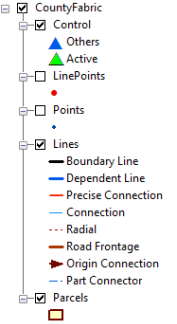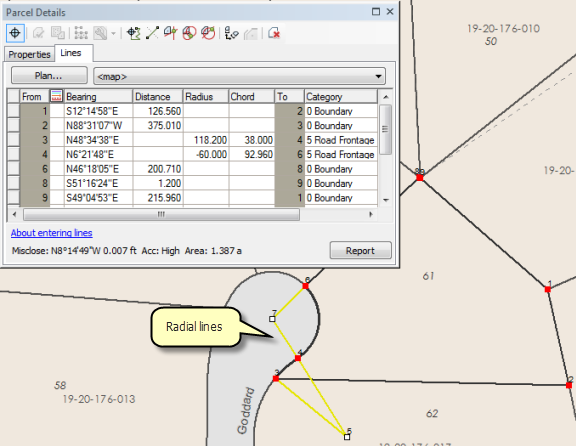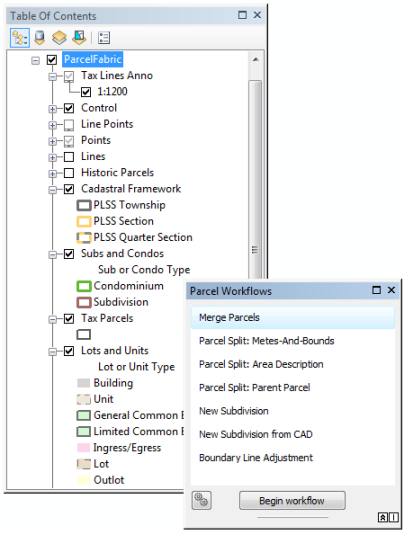Available with Standard or Advanced license.
The parcel fabric is added as a group layer to ArcMap. The internal feature classes that comprise a parcel fabric are represented as sublayers under the parcel fabric group layer.
The parcel fabric group layer is composed of the following set of sublayers:
- Control points
- Line points
- Points
- Lines
- Parcels

A parcel fabric group layer works just like a regular group layer in ArcMap, but layers cannot be added to, or removed from, the parcel fabric group layer.
Each sublayer of the parcel fabric layer can be queried and displayed like normal feature layers in ArcMap. You can right-click each sublayer to display its attribute table. In each sublayer's attribute table, all nonsystem-managed attributes are editable. System-managed attributes, such as FromPointID and ToPointID on the Lines table, are locked and are not editable. The nonsystem-managed attributes of individually selected parcel features can also be edited in the Attributes window. The Attributes window  is located on the Editor toolbar.
is located on the Editor toolbar.
Parcel fabric sublayers can also be individually added to ArcMap as stand-alone layers outside of the parcel fabric group layer.
Control sublayer
The Control sublayer displays control points in the parcel fabric. By default, control points are displayed by their active status. A control point is active if it is turned on in the Control dialog box and is connected to a parcel fabric point. The following attributes are visible in the control sublayer attribute table:
Control attributes
| Attribute field | Description | Editable in attribute table/window |
|---|---|---|
X | X-coordinate; held fixed | No |
Y | Y-coordinate; held fixed | No |
Z | Z-coordinate; held fixed | No |
Name | Control point name; automatically populated if no name is specified | No |
PointID | Corresponding fabric point (A control point needs to be connected to a fabric point to be used in the fabric adjustment.) | No |
AccuracyXY | Horizontal positional accuracy; metadata only | Yes |
AccuracyZ | Vertical accuracy; metadata only | Yes |
Survey Date | The date the control point was surveyed/established | Yes |
Active | True if control point is active and can be used in a fabric adjustment | Yes |
Type | Used for adding subtypes | Yes |
LinePoints sublayer
The LinePoints sublayer displays line points. Line points are those parcel points that sit on the boundary lines of adjacent parcels without splitting the boundary lines. Attribute fields in the line points table are all system managed. The following attributes are visible in the line points sublayer attribute table:
Line points attributes
| Attribute field | Description | Editable in attribute table/window |
|---|---|---|
ParcelID | ID of the parcel containing the boundary line on which the line point sits | No |
FromPointID | From-point of the boundary line on which the line point sits | No |
ToPointID | To-point of the boundary line on which the line point sits | No |
LinePointID | ID of the parcel point that is a line point | No |
FlexPoint | A line point is a flex point if adjacent parcel lines are moved or bent to the line point rather than the line point being moved to the adjacent parcel lines | Yes |
Points sublayer
The points sublayer displays parcel points in the parcel fabric. The following attributes are visible in the points sublayer attribute table:
Points attributes
| Attribute field | Description | Editable in attribute table/window |
|---|---|---|
X | X-coordinate; adjusted in fabric adjustment | No |
Y | Y-coordinate; adjusted in fabric adjustment | No |
Z | Z-coordinate | No |
Type | Used for adding subtypes | Yes |
Category | System-managed point type, for example, center point | Yes |
Name | Name of corresponding control point if there is one | No |
Historical | True if all lines sharing the point are historic | No |
SystemStartDate | Date of database transaction that created the point | No |
SystemEndDate | Date of database transaction that retired the point | No |
LegalStartDate | Date of legal transaction that created the point | Yes |
LegalEndDate | Date of legal transaction that retired the point | Yes |
CenterPoint | True if the point is a center point | No |
MaxDN | Maximum northing shift resulting from a fabric adjustment | No |
MaxDE | Maximum easting shift resulting from a fabric adjustment | No |
Lines sublayer
The lines sublayer displays parcel lines. By default, parcel lines are symbolized by the following internal line categories:
- Boundary Line (Category 0)
Represents the boundary of any closed loop or unclosed parcel in the parcel fabric.
- Dependent Line (Category 1)
Represents lines that are dependent on parcel boundary lines, for example, easement lines. Dependent lines do not define the boundaries of parcels; that is, a closed loop of dependent lines will not create a parcel.
- Precise Connection (Category 2)
Represents lines that connect a parcel point to a control point. Precise connection lines should start at the parcel point and end at the control point and should never start at the control point, that is, be oriented in the reverse direction.
- Connection (Category 3)
Represents lines that connect parcel points. Connection lines are used to add connectivity to the parcel fabric to form a network that can be adjusted in a fabric least-squares adjustment. For example, connection lines are used to connect isolated blocks of parcels. Connection lines do not define the boundaries of parcels; that is, a closed loop of connection lines will not create a parcel.
- Radial (Category 4)
Represents lines that radiate out from the end points of curves to the center points of curves. Radial lines are automatically generated and maintained for curved boundaries. Radial lines are only displayed when a parcel is opened.

Radial lines are displayed when parcels are opened. - Road Frontage (Category 5)
Represents the boundaries of parcels that lie adjacent to roads or right-of-ways. When creating a new parcel, you could use the Road Frontage category instead of using the Boundary category for parcel lines that lie along roads. In a fabric least-squares adjustment, road frontage lines can be constrained to be collinear.
- Origin Connection (Category 6)
Represents lines that connect a point of beginning to the starting point of a parcel. When creating a new parcel, an origin connection line is always entered first, then the remaining traverse lines of the parcel are entered.
- Part Connector (Category 7)
Represents lines that connect the parts and/or rings of a multipart or donut parcel. Part connection lines are automatically generated when multipart or donut parcels are migrated to a parcel fabric. When creating a multipart or donut parcel, part connection lines are used to connect parts and/or rings.
The following attributes are visible in the lines sublayer attribute table:
Lines attributes
| Attribute field | Description | Editable in attribute table/window |
|---|---|---|
Calculated | True if dimensions are inverted from shape geometry | yes |
ParcelID | ID of parcel that contains the line | No |
Sequence | Sequence order number of the line in the parcel traverse | No |
FromPointID | ID of the from-point of the line | No |
ToPointID | ID of the to-point of the line | No |
Bearing | Direction of the line | No |
Distance | Length of the line | No |
Type | Used for adding subtypes | Yes |
Category | Category of the line, for example, connection or radial line | Yes |
Radius | Curved line parameter | No |
ArcLength | Curved line parameter | No |
Delta | Curved line parameter | No |
CenterPointID | ID of the point that is the center point of the curve | No |
Historical | True if the line's associated parcel is historic | No |
Radial Bearing | Bearing of a radial line generated by a curved line | No |
Tangent Bearing | Bearing of the curve tangent | No |
Line Parameters | Specifies whether line is curved or straight | No |
Accuracy | Accuracy level of the line | Yes |
ComputedMinusObserved | The difference between the line shape length (computed) and the line Distance attribute multiplied by the ground-to-grid correction (observed). For curves, the chord length is used. | No |
Internal Angle | Populated when parcel traverse is defined from internal angles instead of bearings | No |
Reference Object | Populated when parcel traverse is defined from internal angles instead of bearings | No |
IsMajor | System-managed field, reserved for storing curves greater than 180 degrees | No |
Hide | True if line dimension is duplicate of overlapping line (Duplicate label will be hidden.) | Yes |
SystemStartDate | Date of database transaction that created the line | No |
SystemEndDate | Date of database transaction that retired the line | No |
LegalStartDate | Date of legal transaction that created the line | Yes |
LegalEndDate | Date of legal transaction that retired the line | Yes |
DensifyType | System-managed field used for storage of natural boundaries | No |
ComputedMinusObserved field
The ComputedMinusObserved field stores an internally calculated value. The value is the difference between the line shape length (computed) and the line Distance attribute multiplied by the ground-to-grid correction (observed). The formula used to calculate the ComputedMinusObserved value is [Shape_Length] - ([Distance] * scale factor), where scale factor is the ground to grid correction obtained from the parcel fabric projection. For curves, the chord length is used. The ground-to-grid correction value is reported by the Point Report tool. Use the Point Report tool to generate a report for one point. Click either the start or end point of the line to see the ground to grid scale for the point.
Parcels sublayer
The parcels sublayer displays the parcel polygons. The following attributes are visible in the parcels sublayer attribute table:
Parcels attributes
| Attribute field | Description | Editable in attribute table/window |
|---|---|---|
Joined | True if the parcel is joined to the fabric | No |
PlanID | ID of the parcel's associated plan | Yes |
Name | Parcel name or parcel identification number (PIN) | Yes |
Type | Used for adding subtypes | Yes |
Stated Area | Area of parcel polygon; automatically calculated if misclose is small; can be edited to reflect recorded plan value | Yes |
Compiled | True if parcel polygon is generated from inverted dimensions | Yes |
Historical | True if parcel is historic; automatically true if Construct from parent or Merge is used | No |
SystemStartDate | Date of the database transaction that created the polygon | No |
SystemEndDate | Date of the database transaction that retired the polygon | No |
LegalStartDate | Date of the legal transaction that created the parcel; should match the plan date | Yes |
LegalEndDate | Date of the legal transaction that retired the parcel; should correspond to the plan date of the replacing parcels | Yes |
GroupID | Populated with an ID if the parcel is part of an unjoined group | No |
Accuracy | Accuracy level of the parcel | Yes |
Rotation | Automatically calculated from the joining process | No |
Scale | Automatically calculated from the joining process | No |
Unclosed | True if the parcel is an unclosed polygon | No |
MiscloseRatio | Ratio of parcel misclose distance to parcel perimeter; system managed | No |
Misclose Bearing | Bearing needed to close the parcel; system managed | No |
Construction | True if the parcel is a construction; system managed | No |
ShapeStdErrorE | Easterly shift/distortion in parcel shape after fabric adjustment; system managed | No |
ShapeStdErrorN | Northerly shift/distortion in parcel shape after fabric adjustment; system managed | No |
BacksightBearing | Populated when parcel is defined from internal angles instead of bearing | No |
Parcel fabric layer enabled with the Local Government Information Model
The parcel fabric can be enabled with the Local Government Information Model. When the Local Government Information Model is enabled on a parcel fabric, parcel types, attributes, and domains that reflect the editing requirements of Local Government parcel maintenance are added to parcel fabric tables. The parcel fabric layer is displayed and symbolized using the Local Government configuration, and the parcel fabric can be used in efficient and automated parcel editing workflows.
Parcels in the parcel fabric layer are displayed by parcel type in a series of sublayers.

Learn more about enabling the parcel fabric with the Local Government Information Model
Querying and displaying the parcel fabric layer
The parcel fabric group layer allows powerful query and display of the parcel fabric. Because parcel fabric feature classes and tables are internally related to each other, the parcel fabric sublayers can be queried with respect to each other. For example, parcels can be queried by their related lines. The following list describes some examples of querying parcels in the parcel fabric:
- Parcels can be queried and displayed by plan (record of survey).
- Parcels can be queried and displayed by line type, for example, road frontage.
- Parcels can be queried and displayed by accuracy level.
- Parcels can be queried and displayed by their misclose information, such as MiscloseRatio and MiscloseDistance.